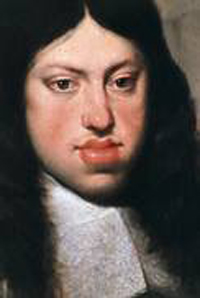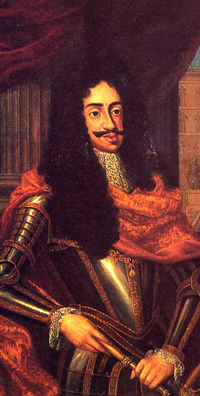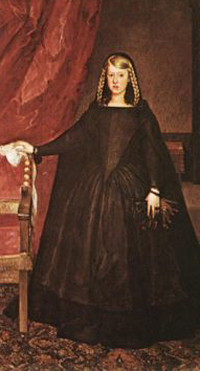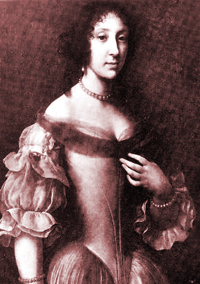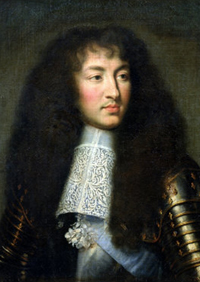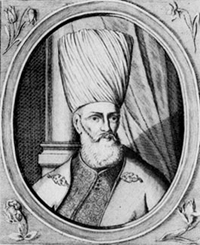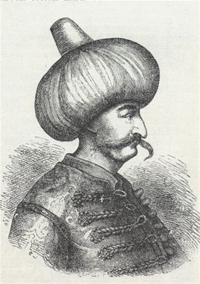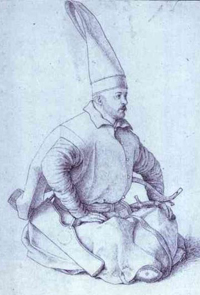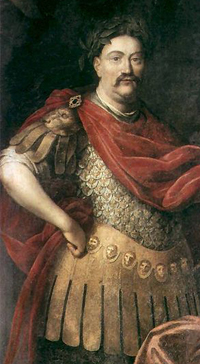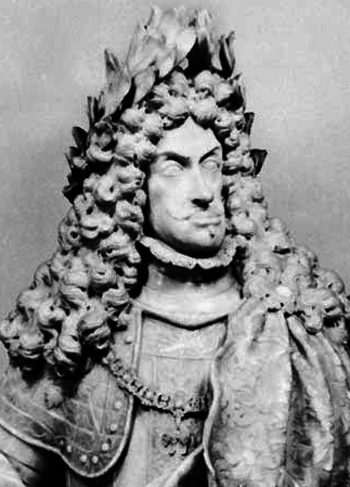
15 KREUZER COIN - AUSTRIA - LEOPOLD I - HABSBURG
(KM 1302) - St. Viet Mint
Date: A.D. 1663
Obverse: Portrait laureate head right - LEOPOLDVS D G. R I S A G H E B REX 15
Reverse: Crowned imperial arms with state shield, mint mark and denomination below - ARCHI AVS E CARINT DVX BVR 1663
Margaret Theresa of Spain: Leopold's niece, cousin, first wife and first love
Archduchess Claudia Felicitas of Austria: Leopold's second wife
Eleonore-Magdalena of Neuburg: Leopold's third wife who bore him eleven children
Charles II: Feeble in mind and body, The death of the last Habsburg King of Spain would spark the War of the Spanish Succession
Louis XIV: An aggressive expansionist policy and a rival claim to the Spanish throne caused many clashes between Leopold and this powerful and shrewd French monarch
Ottoman Grand Vizier Köprülü Mehmed Pasha began the Ottoman push with his occupation of Transylvania
Grand Vizier Köprülü Fazil Ahmed Pasha: Even with his defeat at the Battle of Saint Gotthard, he managed to negotiate favorable terms for the Ottomans in the Treaty of Vasvár
Ottoman Grand Vizier Kara Mustafa Pasha failed to take Vienna and was executed
A 15th century depiction of a Janissary, professional elite soldiers who served the Sultan of the Ottoman Empire
John III Sobieski, King of Poland and Lithuania. Commander of the allied forces during the successful defense of Vienna
Philippe of Anjou, grandson of Louis XIV. As Philip V he succeeded Charles II to become the first Bourbon King Spain |
KM 829 (variant) Austrian Carynthia Silver 15 Kreuzer Depicting Leopold I Archduke of Austria and Holy Roman Emperor. Obv: LEOPOLDVS • D[ei] • G[ratia] (15) • R[omanorvm] • I[mperator] • S[emper] • A[vgvstvs] • G[ermaniae] • H[vngariae] • E[t] • B[ohemiae] • REX (Leopold by the Grace of God Roman Emperor Ever Augustus, King of Germany, Hungary and Bohemia King Rev: Crowned Imperial Arms with oval state shield on chest and mint mark below / ARCHI[dux] • AVS[triae] • E[t] • CARINT[hia] • DVX • BVR[gvndiae] • 1663 (Archduke of Austria and Carynthia, Duke of Burgundy) Leopold Ignaz Joseph Balthasar Felician (Leopold I) was born on June 9, 1640 at Vienna, the second son of Emperor Ferdinand III and Maria Anna. He was born into the House of the Habsburgs, a powerful ruling family of Spain and Austria. Leopold was a part of the imperial family and as such he received the education of a prince with private tutors and mentors to guide him. Leopold's older brother, Ferdinand IV, was to succeed their father thus his education emphasized ecclesiastical matters as the second son would represent and protect Habsburg interests in church affairs. In his youth, Leopold developed a strong appreciation for the arts. Throughout his life he would remain ever concerned with religious matters but he also became a great patron of music. Not only a patron but a musician himself. His court would be filled with the music of great composers as well as some of his own compositions. His brother died of smallpox in 1654 and Leopold became his fathers heir at the age of 14. This event would suddenly change the course of his life and would rapidly propel Leopold to great and unexpected power. His father passed away just three years later and after some opposition to his claim to the throne, concessions were made. More than a year after his father death, he was elected emperor at Frankfurt on August 1, 1658. He was 18 years old. The young emperor was inexperienced and unprepared for the new course his life had taken. He was a man with little military training who would be expected to wage war and direct armies. A man not predisposed to war would now be force to protect his empire from ambitious military monarchs bent on expansion who threatened Austria and the Empire from all sides. War would be a constant during his long reign. Under his reign Austria would be invaded three times, all unsuccessful. Habsburgs House and the Matter of Succession: Leopold was also concerned with the diminished state of his family, the royal House of Habsburg. Inbreeding was commonly used as a political tool to preserve the family's holdings. The results of repeated inbreeding is often credited for the famous 'Hapsburg Jaw' (Prognathism) that was so pronounced in Leopold. The marriages of the Habsburgs have been considered a a clear example of the follies of inbreeding. Cousin married cousin or uncles married nieces, then repeating the same incestuous patterns generation after generation. It was never more apparent or disastrous than in Charles II, Leopold's nephew and cousin, the last of the Spanish Habsburg Kings. Charles was known as 'El Hechizado' or 'the bewitched'. He was said to be feeble in mind and body, plagued with a long list of illnesses, and most likely impotent. He possessed the most pronounced case of the Hapsburg jaw, said to be so deformed that he was unable to chew or speak properly. Charles' immediate family was populated with nieces giving birth to children of their uncles. Charles' mother was a niece of Charles' father. Unable to produce an heir, he named Philip V of Anjou, a Bourbon relation, as his successor. This led to the War of the Spanish Succession upon his death in 1700. Leopold also needed an heir and true to Habsburg form he married Margaret Theresa in 1666. She was both his niece and his first cousin. She was daughter of King Philip IV of Spain and his second wife Mariana of Austria who was also Philips niece. She was the elder sister of Charles II, though she inherited none of the crippling physical defects of inbreeding suffered by her brother. She was betrothed to Leopold as a child and he watched her grow up through a series of wonderful portraits by the great Spanish painter Diego Velázquez. These celebrated portraits of a young princess were painted at different stages of her life, then sent to Leopold in Vienna. She was sent to him to become his wife at the age of 15. By all accounts they got along well sharing a love of art and music and there is little doubt that Leopold loved her. The two had four children, three of whom died shortly after they were born. Their surviving child was a daughter, Maria Antonia, mother of Duke Joseph Ferdinand Leopold of Bavaria who would later become a candidate for the Spanish throne. Margaret died in 1673 at the age of twenty-one leaving Leopold grief-stricken and still without an heir. Leopold wasted no time marrying Archduchess Claudia Felicitas of Austria in October of 1673. She bore him two children, both daughters who did not see their first birthdays. Claudia herself died in 1676, just before her twenty second birthday, three months after the death of her second child. Leopold was again left without an heir. Before the end of that year he had taken a third and final wife. Eleonore-Magdalena was the daughter of Philip Wilhelm of Neuburg, Elector of the Palatinate. She was sister to Maria Anna, the unfortunate wife of Charles II of Spain. She bore eleven children by Leopold, eight daughters and three sons. One son would die soon after he was born, the other two sons would go on to be emperors. After 16 children by three woman he had finally secured an heir and successor in his eldest son Joseph I. Conflicts: Leopold was forced to deal with the continued expansion of the Ottoman Empire under the powerful Köprülü Grande Viziers: Mehmed Köprülü, Fazil Ahmed Pasha, and Kara Mustafa Pasha. He would also have repeated clashes with France and its King, Louis XIV. The map of Europe was ever changing and armies were always on the march. Treaties made and broken and Leopold had to learn on the job. The Holy Roman Empire was a loose confederation of independent states. It was difficult for the emperor to gather a strong, cohesive, and effective force for a long period of time as each state had its own concerns and agendas. He could not simply rally the troops on command, it often required well orchestrated diplomacy and coercion. One of his first concerns was the empire's involvement in the Northern Wars as an ally of Poland against Sweden. The war was concluded in 1660 with the treaty of Oliva allowing Leopold to turn his attention to other pressing matters. The Holy Roman Empire would have very few moments of peace as war with the Ottoman Empire would soon erupt as well as many conflicts with France and its extravagant and ambitious monarch, Louis XIV. The embattled state of Hungary was a constant war zone which had been partitioned into Royal Hungary, held by Austria, and Turkish Hungary, held by the Ottoman Empire. Transylvania had escaped the invasion of Europe by the Ottoman Turks relatively unscathed. They remained a semi-independent principality with ties to Austria but paid a tribute to the Turks in exchange for political and religious autonomy. There was a measure of religious freedom outside the sway of the Catholic church and its authority giving rise to a mix of religious beliefs being officially tolerated. After the failed invasion of Poland by Transylvanian Prince György Rákóczi II in 1657, the Ottoman Empire looked to take more direct control of what they saw as a rouge nation starting unjustified wars. This led to an occupation of Transylvania by Ottoman forces under the Grande Vizier Köprülü Mehmed Pasha. Upon the death of Rákóczi, the new prince of Transylvania, Janos Kemény, fled to Vienna seeking aid. The Ottomans took control of Transylvania and quickly looked to build up its forces to defend against the inevitable backlash. Leopold, a Catholic, did not approve of the more varied and open religious climate and did not want the Turks on his borders. Leopold set to gathering support from allies assembling a fighting force of almost 20,000 under the command of Count Raimondo Montecuccoli. These forces consisted of troops from Austria, Holy Roman Imperial, Rhine States, Hungary, Italy, as well as a contribution of 3,000 infantry and almost 2,000 cavalry from France, a most uneasy alliance. The Ottoman Empire declared war on Austria in April of 1663 but an invasion took a full year to materialize. This allowed time for allied troops to assemble on the River Rába which now separated the Turkish forces from Austria. Ottoman forces crossed the river on August 1, 1664, engaging the defenders and successfully driving them back. Out numbered but better equipped, Montecuccoli and the assembled forces reformed, rallied, and launched a counter attack. At the Battle of Saint Gotthard, allied defenders caught Ottoman forces by surprise sending them running back towards the river where many drowned. Ahmed Köprülü was unable to send the rest of his army across the river and withdrew after suffering high casualties. The Treaty of Vasvár was signed soon after. The terms of this peace treaty heavily favored the Ottoman Empire although they had just suffered defeat. It is generally thought that Leopold failed to follow through and translate success on the battle field into leverage at the negotiation table. In return for a guarantee of 20 years peace with the Turks, Leopold agreed to pay the unsuccessful invaders war reparations. Displaced Hungarian and Croat nobles were incensed to learn that their lands would not be returned to them as the treaty recognized Ottoman control of Transylvania and abandoned any notion of liberating Ottoman held Hungary for the time being. Many saw this treaty as a diplomatic failure but Leopold saw it as buying time. He was not done with the Ottomans nor had he abandoned Hungary permanently. He knew that many of the assembled forces under Montecuccoli would not stay on for a more protracted war against the Ottomans for Hungary, it would have to wait. He was faced with French expansion and aggression and the problematic succession of the Spanish throne for which both Leopold and Louis had staked a claim. With his eyes on Spain and France, Leopold chose to accept much more unfavorable terms. This did not end his troubles with the Ottoman Empire, it merely delayed any major conflict. Although Leopold I and Louis XIV are often portrayed as archenemies, there was at times a measure of cooperation. Louis sent troops to fight back the Turks while Leopold chose not to take sides in the matter of Frances aggression towards the Dutch provinces. He even signing a non-aggression pact with France in 1671. This peace was broken when Leopold eventually sided with the Dutch in the Franco-Dutch war which ended with the Treaties of Nijmegen in 1678. The treaty was mostly favorable to France who gained control of the Franche-Comté and some cities in Flanders and Hainaut. As usual, the peace was short lived. Louis did not curb his aggressive expansion and initiated the Chambers of Reunion whereby France lay claim to all dependencies claimed by any of his newly incorporated states, past or present. Often such claims, as in the case of the City of Strasbourg, were invented. Louis thus took advantage of his alliance treaties with the German princes by claiming their land. This included Luxembourg, at the time a part of the Holy Roman Empire. Again Leopold joined with allies to challenge the further expansion of France but he found himself over taxed. The continuing trouble in Austrian held Hungary and his harsh treatment of protestants there had caused unrest and uprisings. Protestants preferred the apathy shown by the Ottomans regarding what Christian religion was practiced in their territory over Leopold's stanch insistence on Catholic supremacy and his desire to abolish Protestantism. The veteran Ottoman military leader, now the Grande Vizier, Kara Mustafa Pasha, was happy to help. Looking to end nearly 150 years of conflict between the Ottoman Empire and Austria, he sent a large invasion force, reported to number around 100,000, into Austria in 1683. Leopold was caught unprepared and Ottoman forces marched virtually unopposed to the city of Vienna which was guarded by 10,000 Habsburg troops. Leopold retreated to Passau and scrambled to rally his troops and his allies to the defense of Austria as Ottoman forces lay siege to Vienna. The siege began in July, by September the Turks had made significant progress and appeared to be on the verge of taking the city. Kara Mustafa Pasha chose a long protracted siege instead of an all out assault on the under defended city, possibly looking to take the city as undamaged as possible. The long siege gave Leopold time to rally support in the form of several German states and Poland with whom he signed a mutual protection treaty. The King of Poland, John III Sobieski (the lion of Lichtenstein), sent a large force, leaving his own lands exposed to attack, and was placed in command of the allied forces. A brilliant military commander, Sobieski vigorously took up the defense of Vienna. His own 30,000 man force combined with almost 19,000 Austrian troops, 19,000 Franconian, Swabian and Bavarian troops, and 9,000 Saxon troops and engaged Ottoman forces on September 12, 1683. The Turkish commanders intended to take Vienna before Sobieski arrived, but time ran out. Ottoman forces had dug tunnels under the city walls so they could be destroyed by explosive charges, but defenders found these tunnels and removed the charges before they could do much damage. Polish forces attacked Turkish forces who were attempting to break the defenses and enter the city. After 12 hours of fighting, Sobieski's Polish force held the high ground. Sobieski ordered what would be the largest cavalry charge in history. It consisted of four cavalry groups, one Austrian-German and three Polish, a total of over 20,000 men charged down the hills. This charge broke the Ottoman line. They were exhausted from the long fight on two sides and broke off engagement. The cavalry headed straight for the Ottoman camps, while the remaining Vienna garrison pushed out of the city and joined in the assault. The Ottoman army, tired and dispirited, retreated to the south and east. The failure at Vienna sealed the fate of the Grande Vizier. Kara Mustafa Pasha was executed shortly after his defeat at the order of the commander of the Janissaries. He was strangled by a silk rope and his head was severed and sent to Sultan Mehmed IV in a velvet bag. The defeat at Vienna would be the first in a line of defeats for the Ottoman Empire in Europe. Ottoman forces were soundly defeated at the battle of Senta in 1697. This led to the Treaty of Karlowitz which forced the Ottomans to cede most of Hungary, Transylvania and Slavonia to Austria, while Podolia returned to Poland. It was also in 1697 that England, Spain, and the United Provinces (which included Austria) made peace with France at the Treaty of Rijswijk. The aggressive expansion of France had culminated in the formation of the Grand Alliance in May of 1689. This Alliance included the emperor, the kings of England, Spain, Denmark, and the elector of Brandenburg, among others. Its purpose was to end the threat of French aggression. The Treaty of Rijswijk was signed after almost ten years of conflict which included almost the whole of western Europe. Under the treaty, France was to return almost all towns and districts seized since the Treaty of Nijmegen. They also surrendered Freiburg, Breisach and Philippsburg to the Holy Roman Empire. Peace with France never lasted long. The issue of Spain upon the death of its king had long been a concern for the two main claimants to the throne, Leopold I and Louis XIV. Charles II, as a part of the Spanish branch of the Habsburg family, was cousin to Leopold. Louis claimed the right as his mother was a Habsburg, the Daughter of King Philip III of Spain and sister to King Philip the IV. This made Louis XIV a cousin of Charles II. Furthermore Louis XIV was married to Maria Theresa of Spain, his first cousin. This made his son, Louis the Dauphin of France, the most direct descendant and the person with the strongest legitimate claim to the throne of Spain. The issue of Spanish Succession was not just a concern to the two main claimants to the Spanish Throne but to all the leaders of Europe at the time. France and Austria were the two most powerful nations in Europe. If either family took full possession of Spain and all its holdings, it would cause a tip in the balance of power making one or the other the most powerful nation on the continent. The object was to deny both the King of France and the Austrian Habsburgs total control of Spain. Louis the Dauphin was his father heir thus the future King of France. If he were given the Spanish throne, France would hold all of Spain and its territories. Leopold wished for Spain to go to his second son, the Archduke Charles VI. Louis chose his grandson, Philippe of Anjou. Other world powers preferred Duke Joseph Ferdinand Leopold of Bavaria, grandson to Leopold I through his daughter from his first marriage. This would remove Spain from direct Habsburg control as Duke Joseph Ferdinand was a Wittelsbach, a German royal family, and not a Habsburg. A partition treaty was signed between England and France that named Joseph Ferdinand of Bavaria as heir to the throne. Under the First Partition Treaty in 1698, France would get some territories as would Austria effectively stripping Spain of its holdings. This was unacceptable to the Spanish. Charles II of Spain agreed to name the Bavarian Prince his heir, but insisted he inherit the whole of Spanish lands. Spain would not be partitioned on the agreement of other nations. When Joseph Ferdinand died of smallpox in 1699, the issue of who would succeed the Spanish king was reopened. Again England and France met to decide the fate of Spain. They signed the Second Partition Treaty (Treaty of London) in March of 1700 which named Archduke Charles as heir to the Spanish throne. The treaty would again partition Spain as Charles would inherit Spain but not its Italian holdings which would go to France. Although the treaty named his second son as successor, Leopold was displeased with the treaty and angered that Austria was not consulted. Austria wanted Spain and all its holdings to be passed on as a whole and saw the Italian territories as the most desirable. Spain was displeased as they had made it clear they did not want the country partitioned by foreign powers. Charles II and his Spanish advisers made their own plans. As the French contingent in the Spanish court was much stronger, he named the Dauphin's second son, Philippe of Anjou, as heir to Spain and all its holdings. In an effort to keep Spain in one piece, he stipulated that Spain must go as a whole to Anjou. If he could not, or would not agree to this, then his younger brother, Charles Duke of Berri, would be named. Designated third in line would be Archduke Charles. Louis XIV believed that upon the death of Charles II, England would not commit to the inevitable conflict that would come from enforcing the Partition Treaty they had signed without the consent of Spain and Austria. Nor would all parties involved respect the all or nothing succession as spelled out by King Charles II himself. War seemed inevitable so Louis chose to accept the Spanish kings wishes which gave Spain and all of its holdings to his Grandson. Upon the death of Charles II on November 1, 1700, Louis proclaimed Philippe of Anjou the next King of Spain contrary to the Partition Treaty. Anjou would rule as King Philip V, the first Bourbon King of Spain. Although William III of England reluctantly accepted the situation as he was unable to garner support for a war. Louis XIV quickly supplied reason enough when he denied England and the Netherlands the right to trade with Spain. Leopold and William negotiated the Treaty of Den Haag with the United Provinces in September of 1701. The agreement recognized Philip V as King of Spain but allotted Austria the Spanish held territories in Italy they so desired. It also allowed England and the Netherlands to retain their commercial rights in Spain and formed a defensive alliance against France. The War of the Spanish Succession began. Both sides tasted success and defeats in the first years of the war but little progress was made. In 1704, Louis XIV decided on a bold move. He would march on Vienna and remove Leopold and Austria as a threat. With Austria out of the picture he hoped to gaining a favorable peace settlement. Austrian and allied troops met French and Bavarian troops at the pivotal Battle of Blenheim where French and Bavarian Troops were soundly defeated. French losses were immense: some 30,000 killed, wounded, and missing. France lost its Bavarian allies. Many of the Bavarian troops who had not been killed, deserted as they retreated towards home. Louis’ hopes of an early and victorious peace had been thwarted. The battle commonly marks the turning point in the war in favor of the Austrian and English allies. Leopold I would not live to see the conclusion of the war as he died the next year, shortly before his 65th birthday on May 5, 1705. He had reigned for almost 45 years. He was succeeded by his eldest son, Joseph I, who would continue Austria's involvement in the war. Joseph would reign for little more than five years until his death from smallpox. Leopold's second son, Charles VI would succeed his brother in 1711 and would also continue the war effort. Roughly three years into the reign of Charles VI, the war would conclude. Brittan and the Netherlands would leave the war in 1713 with the signing of the Treaty of Utrecht. Hostilities between France and Austria would continue until 1714 when the Treaties of Rastatt and Baden were ratified marking the end of the War. Under the Treaty of Utrecht, Philip V would remain King of Spain but the Spanish Netherlands and much of Spain's Italian territories would go to Austria. Leopold was young and inexperienced when he rose to the head of the Austrian Habsburg family and the loose assembly of states that was the Holy Roman Empire. He quickly learned how to rally support of member states and became a capable and cautious politician when dealing with allies and enemies. Through competent political maneuvering, alliances, and military action, he halted the advance of the Ottoman empire into Europe, reclaimed land for Austria and the Holy Roman Empire, and sought to check French expansion at every turn. Leopold ably led one of the most powerful entities in Europe through a time of great turmoil, war, and upheaval. A staunch Catholic and a proponent of the counter reformation, Leopold was also highly educated and industrious with a love for music. What Leopold may have lacked in charisma he made up for in tenacity. He was short and physically unimpressive but relatively healthy as he enjoyed physical activities such as hunting and riding. In the words of historian William Coxe: 'In his gait he was stately, slow and deliberate, his air pensive, his address awkward, his manner uncouth, his disposition phlegmatic'. He possessed a more extreme example of the Habsburg jaw which is evident from his portraits which depict it rather consistently. On his coins this feature is depicted less consistently ranging from a slight protrusion to the extremely pronounced distended jaw which led to the nickname: Leopold the Hogmouth.
|


